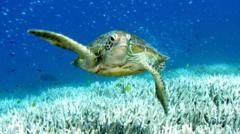The article text:
Australia's natural landmarks are often ranked among the world's finest, with the Great Barrier Reef earning its place as the largest coral reef system and a UNESCO World Heritage Site. But on the north-western coast lies Ningaloo Reef, a lesser-known but equally impressive contender. As the world's largest fringing reef, it boasts an expansive oceanic forest and draws visitors eager to snorkel amidst vibrant corals and diverse marine life, including manta rays and whale sharks.
This year, however, Ningaloo Reef has been grappling with troubling news. A sweeping marine heatwave is escalating coral stress levels, triggering a bleaching phenomenon. While some corals may bounce back, scientists face grim realities as damage mounts. In fact, this widespread bleaching event marks the first occasion where both the eastern and western Australian reefs have succumbed to such conditions.
Paul Gamblin, leader of the Australian Marine Conservation Society, articulated the dire situation, likening it to a relentless underwater bushfire that has been causing devastation for months. “It’s unprecedented,” he claimed. The marine heatwave began in the Caribbean and has since migrated through the Indo-Pacific, culminating in record-high temperatures along Australia’s coast.
Dr. Kate Quigley, a leading scientist at Minderoo Foundation, explained that increased water temperatures disrupt the symbiotic relationship between corals and their algae partners, leading to bleaching. This year’s prolonged warmth has raised alarm bells among researchers, as temperatures failed to retreat after summer.
Surveys after the bleaching event indicate a significant uncertainty regarding coral survival. Dr. Tom Holmes, Marine Science Programme Leader in Western Australia, noted the unpredictability of recovery processes, saying natural variability complicates predictions. Meanwhile, Ningaloo attracts about 200,000 annual tourists, which is now at risk, leading locals to fear a decline in tourism due to visible coral damage.
The detrimental effects of increased carbon emissions and rising global temperatures are evident, with substantial links to government-sanctioned fossil fuel projects such as the North West Shelf gas plant. These contrasting priorities pose significant ecological dilemmas according to marine conservation experts, suggesting an urgent need for policy reevaluation.
In light of the ongoing crisis, researchers at the University of Queensland are employing drone technology to monitor reef health, while others are experimenting with breeding more resilient coral strains. However, critics argue such measures only provide temporary relief and that effective long-term solutions require addressing fundamental causes like carbon emissions. There’s a familiar sense of urgency as scientists emphasize the wider ecological benefits that coral reefs provide to human life on the planet.
Despite the challenges, conservationists continue to advocate for a balance between economic interests and environmental preservation, calling for swift action to safeguard these irreplaceable marine habitats from the ongoing implications of climate change.
Australia's natural landmarks are often ranked among the world's finest, with the Great Barrier Reef earning its place as the largest coral reef system and a UNESCO World Heritage Site. But on the north-western coast lies Ningaloo Reef, a lesser-known but equally impressive contender. As the world's largest fringing reef, it boasts an expansive oceanic forest and draws visitors eager to snorkel amidst vibrant corals and diverse marine life, including manta rays and whale sharks.
This year, however, Ningaloo Reef has been grappling with troubling news. A sweeping marine heatwave is escalating coral stress levels, triggering a bleaching phenomenon. While some corals may bounce back, scientists face grim realities as damage mounts. In fact, this widespread bleaching event marks the first occasion where both the eastern and western Australian reefs have succumbed to such conditions.
Paul Gamblin, leader of the Australian Marine Conservation Society, articulated the dire situation, likening it to a relentless underwater bushfire that has been causing devastation for months. “It’s unprecedented,” he claimed. The marine heatwave began in the Caribbean and has since migrated through the Indo-Pacific, culminating in record-high temperatures along Australia’s coast.
Dr. Kate Quigley, a leading scientist at Minderoo Foundation, explained that increased water temperatures disrupt the symbiotic relationship between corals and their algae partners, leading to bleaching. This year’s prolonged warmth has raised alarm bells among researchers, as temperatures failed to retreat after summer.
Surveys after the bleaching event indicate a significant uncertainty regarding coral survival. Dr. Tom Holmes, Marine Science Programme Leader in Western Australia, noted the unpredictability of recovery processes, saying natural variability complicates predictions. Meanwhile, Ningaloo attracts about 200,000 annual tourists, which is now at risk, leading locals to fear a decline in tourism due to visible coral damage.
The detrimental effects of increased carbon emissions and rising global temperatures are evident, with substantial links to government-sanctioned fossil fuel projects such as the North West Shelf gas plant. These contrasting priorities pose significant ecological dilemmas according to marine conservation experts, suggesting an urgent need for policy reevaluation.
In light of the ongoing crisis, researchers at the University of Queensland are employing drone technology to monitor reef health, while others are experimenting with breeding more resilient coral strains. However, critics argue such measures only provide temporary relief and that effective long-term solutions require addressing fundamental causes like carbon emissions. There’s a familiar sense of urgency as scientists emphasize the wider ecological benefits that coral reefs provide to human life on the planet.
Despite the challenges, conservationists continue to advocate for a balance between economic interests and environmental preservation, calling for swift action to safeguard these irreplaceable marine habitats from the ongoing implications of climate change.





















